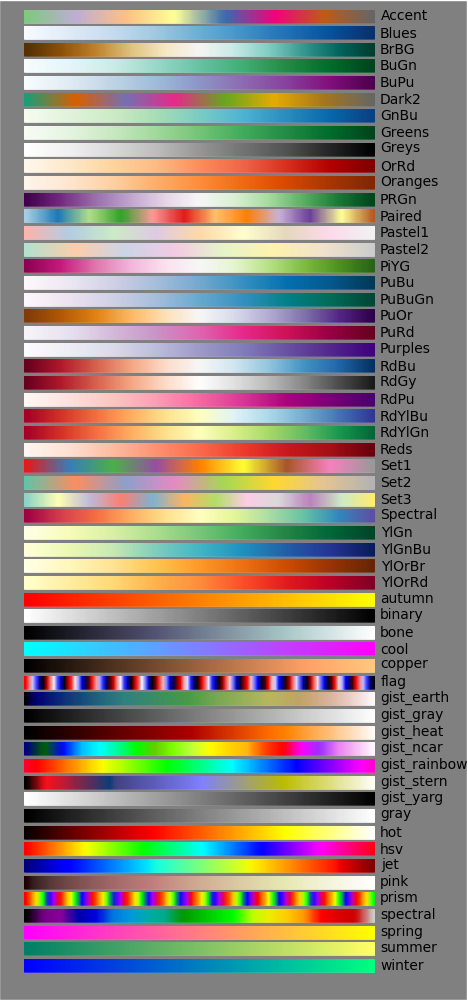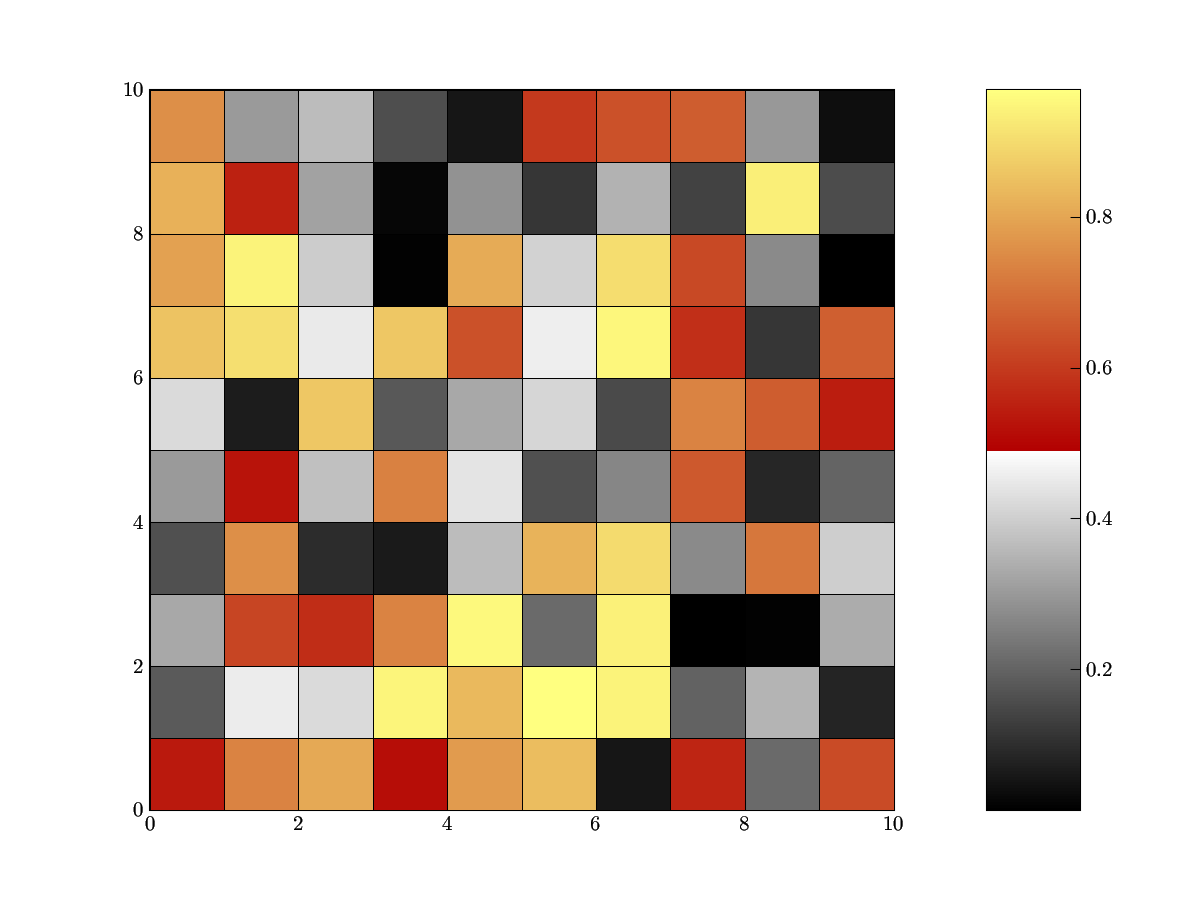Matplotlib:显示颜色映射¶
| 日期 | 2012-06-06(最后修改),2006-01-22(创建) |
|---|
显示 Matplotlib 颜色映射
In [ ]
#!python
from pylab import *
from numpy import outer
rc('text', usetex=False)
a=outer(arange(0,1,0.01),ones(10))
figure(figsize=(10,5))
subplots_adjust(top=0.8,bottom=0.05,left=0.01,right=0.99)
maps=[m for m in cm.datad if not m.endswith("_r")]
maps.sort()
l=len(maps)+1
for i, m in enumerate(maps):
subplot(1,l,i+1)
axis("off")
imshow(a,aspect='auto',cmap=get_cmap(m),origin="lower")
title(m,rotation=90,fontsize=10)
savefig("colormaps.png",dpi=100,facecolor='gray')

但是,如果我认为这些颜色映射很丑呢?好吧,只需使用 matplotlib.colors.!LinearSegmentedColormap 创建自己的颜色映射即可。
首先,创建一个脚本,将范围 (0,1) 映射到 RGB 光谱中的值。在这个字典中,您将有一系列针对每个颜色“红色”、“绿色”和“蓝色”的元组。这些颜色系列中的第一个元素需要从 0 到 1 排序,并在它们之间具有任意间距。现在,考虑下面“红色”系列中的 (0.5, 1.0, 0.7)。这个元组表示在 (0,1) 范围内的 0.5 处,从下方插值到 1.0,从上方插值到 0.7。通常,每个元组中的后两个值将相同,但使用不同的值有助于在颜色映射中添加断点。这比听起来更容易理解,正如这个简单的脚本所示
In [ ]
#!python
from pylab import *
cdict = {'red': ((0.0, 0.0, 0.0),
(0.5, 1.0, 0.7),
(1.0, 1.0, 1.0)),
'green': ((0.0, 0.0, 0.0),
(0.5, 1.0, 0.0),
(1.0, 1.0, 1.0)),
'blue': ((0.0, 0.0, 0.0),
(0.5, 1.0, 0.0),
(1.0, 0.5, 1.0))}
my_cmap = matplotlib.colors.LinearSegmentedColormap('my_colormap',cdict,256)
pcolor(rand(10,10),cmap=my_cmap)
colorbar()

如您所见,颜色映射在中间有一个断点。请负责任地使用这种新功能。
以下是上述代码的略微修改版本,它允许显示预定义颜色映射的选择以及自创建的注册颜色映射。请注意,cm 模块中的 cmap_d 字典没有记录。discrete_cmap 中的索引颜色选择有些随意...
In [ ]
"""Python colormaps demo
includes:
examples for registering own color maps
utility for showing all or selected named colormaps including self-defined ones"""
import matplotlib
import matplotlib.colors as col
import matplotlib.cm as cm
import matplotlib.pyplot as plt
import numpy as np
def register_own_cmaps():
"""define two example colormaps as segmented lists and register them"""
# a good guide for choosing colors is provided at
# http://geography.uoregon.edu/datagraphics/color_scales.htm
#
# example 1:
# create own colormap from purple, blue, green, orange to red
# cdict contains a tuple structure for 'red', 'green', and 'blue'.
# Each color has a list of (x,y0,y1) tuples, where
# x defines the "index" in the colormap (range 0..1), y0 is the
# color value (0..1) left of x, and y1 the color value right of x.
# The LinearSegmentedColormap method will linearly interpolate between
# (x[i],y1) and (x[i+1],y0)
# The gamma value denotes a "gamma curve" value which adjusts the brightness
# at the bottom and top of the colormap. According to matlab documentation
# this means:
# colormap values are modified as c^gamma, where gamma is (1-beta) for
# beta>0 and 1/(1+beta) for beta<=0
cdict = {'red': ((0.0, 0.0, 0.0),
(0.3, 0.5, 0.5),
(0.6, 0.7, 0.7),
(0.9, 0.8, 0.8),
(1.0, 0.8, 0.8)),
'green': ((0.0, 0.0, 0.0),
(0.3, 0.8, 0.8),
(0.6, 0.7, 0.7),
(0.9, 0.0, 0.0),
(1.0, 0.7, 0.7)),
'blue': ((0.0, 1.0, 1.0),
(0.3, 1.0, 1.0),
(0.6, 0.0, 0.0),
(0.9, 0.0, 0.0),
(1.0, 1.0, 1.0))}
cmap1 = col.LinearSegmentedColormap('my_colormap',cdict,N=256,gamma=0.75)
cm.register_cmap(name='own1', cmap=cmap1)
# example 2: use the "fromList() method
startcolor = '#586323' # a dark olive
midcolor = '#fcffc9' # a bright yellow
endcolor = '#bd2309' # medium dark red
cmap2 = col.LinearSegmentedColormap.from_list('own2',[startcolor,midcolor,endcolor])
# extra arguments are N=256, gamma=1.0
cm.register_cmap(cmap=cmap2)
# we can skip name here as it was already defined
def discrete_cmap(N=8):
"""create a colormap with N (N<15) discrete colors and register it"""
# define individual colors as hex values
cpool = [ '#bd2309', '#bbb12d', '#1480fa', '#14fa2f', '#000000',
'#faf214', '#2edfea', '#ea2ec4', '#ea2e40', '#cdcdcd',
'#577a4d', '#2e46c0', '#f59422', '#219774', '#8086d9' ]
cmap3 = col.ListedColormap(cpool[0:N], 'indexed')
cm.register_cmap(cmap=cmap3)
def show_cmaps(names=None):
"""display all colormaps included in the names list. If names is None, all
defined colormaps will be shown."""
# base code from https://scipy.org.cn/Cookbook/Matplotlib/Show_colormaps
matplotlib.rc('text', usetex=False)
a=np.outer(np.arange(0,1,0.01),np.ones(10)) # pseudo image data
f=plt.figure(figsize=(10,5))
f.subplots_adjust(top=0.8,bottom=0.05,left=0.01,right=0.99)
# get list of all colormap names
# this only obtains names of built-in colormaps:
maps=[m for m in cm.datad if not m.endswith("_r")]
# use undocumented cmap_d dictionary instead
maps = [m for m in cm.cmap_d if not m.endswith("_r")]
maps.sort()
# determine number of subplots to make
l=len(maps)+1
if names is not None: l=len(names) # assume all names are correct!
# loop over maps and plot the selected ones
i=0
for m in maps:
if names is None or m in names:
i+=1
ax = plt.subplot(1,l,i)
ax.axis("off")
plt.imshow(a,aspect='auto',cmap=cm.get_cmap(m),origin="lower")
plt.title(m,rotation=90,fontsize=10,verticalalignment='bottom')
plt.savefig("colormaps.png",dpi=100,facecolor='gray')
if __name__ == "__main__":
register_own_cmaps()
discrete_cmap(8)
show_cmaps(['indexed','Blues','OrRd','PiYG','PuOr',
'RdYlBu','RdYlGn','afmhot','binary','copper',
'gist_ncar','gist_rainbow','own1','own2'])
部分作者:AndrewStraw、Unknown[95]、Unknown[91]、NeilMB、Unknown[112]、DavidLinke、Unknown[113]、newacct、Unknown[114]
附件